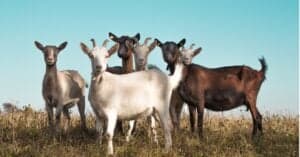The modern goat, Capra hircus, evolved from wild ancestors around 10,000 years ago. But, they didn’t adapt and become the goats they are today on their own. Instead, through the process of domestication, humans have spent thousands of years carefully planning goat gestation. The end result can be seen in the over 300 species of goat living around the world today. Closely related to domestic sheep, goats, along with cows, pigs, horses, and chickens, are some of the most important livestock animals around.
Here, we’ll learn all there is to know about goats, including what they look like, what they eat, and how they spend their days. Then, we’ll take a closer look at goat gestation, learn how often goats have babies and how many they have at a time. We’ll discover how to tell if a goat is pregnant. Finally, we’ll find out why some mother goats reject their newborn kids.
Read on to learn more about goat gestation!
Goat: Background

Domestic goats belong to the Bovidae family of animals, which also includes
antelope
, cattle, and mountain goats.
©Andrea Kraus-Wirth/Shutterstock.com
There are around 1 billion domestic goats in the world today. Typically, goats have horns that may spiral or curve, as well as beards. They’re herbivores who benefit from forbs, grasses, and some grain. Goat gestation and understanding how to take care of pregnant does and their kids is of vital concern to goat ranchers the world over.
Size and Appearance
Goats are four-legged, hoofed mammals that typically stand under three feet tall. They range in size from the size of a small dog to the size of a pony. Some have large, flapping ears, while others have short, stiff ears. All goats have horizontally elliptical pupils, which gives them a characteristic look unique to goats. Both males and females have beards on their necks, and females have udders for producing milk.
Goats come in various colors, including brown, tan, black, and white. Most have medium-length tails that they use to swat flies away. Goats tend to be short and sturdily built, like their wild ancestors.
Diet and Behavior

Like all ruminants, goats actually chew their food twice.
©Florence Bond – Copyright A-Z Animals
Despite their reputation, goats will not eat just anything. They’re browsers, who spend most of their waking hours eating and rechewing their food. One of their favorite things to do is chew on items to see if they’re edible. Goats generally eat woody plants, shrubs, and even tree bark. They also eat weeds, vines, and leafed plants. Because of their browsing habits, they’re typically kept free range, rather than in stalls.
Like sheep, goats are herd animals. Goat gestation is a large part of the herd dynamic, with females tending to kids at around the same time of year. Females raise young with attentive care until weaning, while males have nothing to do with the kids.
Reproduction: What Age Can Goats Get Pregnant?
Female goats become sexually mature as early as four months, though it may take up to 12 months for them to complete puberty. Male goats are ready to go as young as four months and become progressively more fertile until they reach around four years of age. When does (female goats) reach reproductive maturity, they begin going into heat every 21 days. During this heat, they have a 12-36 hour window in which to get pregnant. Because of this monthly estrous cycle, goat gestation can begin at any time of the year. Many breeders choose to breed their goats in the fall so that kids are born in the early spring.
How Many Months are Goats Pregnant?

Goats are pregnant for an average of 5 months.
©Florence Bond – Copyright A-Z Animals
Goat gestation periods last anywhere from 145-155 days, with the average being 150 days. A typical goat pregnancy is five months long. Pregnancy duration is affected by the environment, the breed of goat, and whether or not this is the goat’s first gestation. Five months is far shorter than the 22 months that African elephants are pregnant for, and it’s much longer than the 12-day gestation of the Virginia opossum.
How Many Kids do Goats Have?
Goat mothers can have anywhere from 1-4 kids per pregnancy. Typically, a nanny’s first gestation results in only one or two babies. But, after that, it’s common for mother goats to have up to four kids per pregnancy. Kids rely solely on their mother’s milk for the first weeks of life before weaning onto grasses and forbs. By the time they’re four months old, they’re sexually mature and ready to make more baby goats. However, most breeders wait until their goats are a little older to breed them.
How Do You Tell if a Goat is Pregnant?
If goat gestation occurs, one of the first signs is that the female no longer goes into heat. She won’t go into heat again until her kids are weaned. Pregnant goats also eat more and produce less milk during gestation. Their bellies get tighter in appearance, and they tend to act differently than they did before pregnancy. Further, her udder will swell, and when she sleeps, she’s likely to snore.
Why Do Mother Goats Sometimes Reject Their Babies?
Often, goat gestations end with the mother rejecting one or all of her babies. This may happen in cases of unhealthy or malformed newborns. It may also happen in cases of multiple kids, where the mother goat only takes care of certain babies. Finally, if the mother goat is stressed or threatened at the time of birth, she may reject her kids out of self-preservation.
The photo featured at the top of this post is © goodbishop/Shutterstock.com
Thank you for reading! Have some feedback for us? Contact the AZ Animals editorial team.






